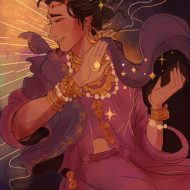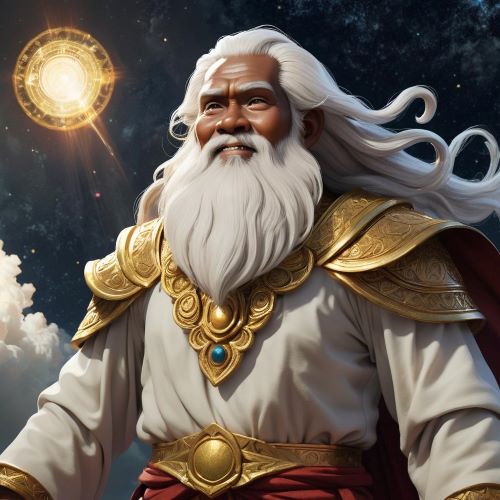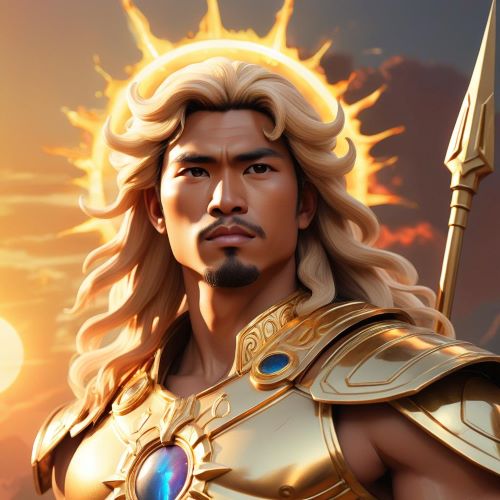Hanan : The Morning Goddess
Listen
At a glance
| Description | |
|---|---|
| Origin | Philippine Mythology |
| Classification | Demigods |
| Family Members | Bathala (Father), Mayari, Tala (Sisters) |
| Region | Philippines |
| Associated With | Morning, Dawn |
Hanan
Introduction
Nestled within the Philippines, a nation renowned for its rich and vibrant mythology, thrives a myriad of divine entities and otherworldly beings that have ignited the creative sparks of countless generations. Among these captivating characters, Hanan emerges as a luminescent and cherished goddess. Hanan, the embodiment of morning and daylight, ushers in illumination and optimism to the archipelago, serving as a pivotal cornerstone within the intricate fabric of Filipino folklore.
Hanan, the goddess of morning and day, shines brightly in the pantheon of Philippine mythology. Her origins, attributes, and significance are deeply ingrained in the cultural fabric of the Philippines. She represents the eternal cycle of light and darkness, offering hope, warmth, and prosperity to those who embrace her radiant presence.
Physical Traits
Hanan’s physical attributes are a reflection of her radiant and captivating nature. Her skin exudes a warm, golden glow, mirroring the brilliance of the morning sun, a symbol of the light and hope she bestows upon the world. Complementing her luminous skin, her hair is as dark as the night, creating a striking contrast that adds to her overall allure.
Adorned with opulent golden jewelry, including necklaces, bracelets, and anklets, Hanan embodies the warmth and brilliance of the morning sun. These precious ornaments not only enhance her beauty but also emphasize her celestial status. Her attire is a testament to the vivid colors of dawn, featuring shades of pink, orange, and red that echo the hues of the sunrise as she emerges from the eastern horizon.
In some depictions, Hanan is embellished with sunflowers, a poignant symbol closely associated with her. These sunflowers, with their bright yellow petals, serve as a visual representation of the sun’s radiant rays, further highlighting her celestial connection. Hanan’s physical form is graced with a captivating and graceful presence that embodies the ideals of beauty, grace, and elegance. Her appearance reflects her status as a revered deity, captivating all who encounter her with her celestial charm.
Family
Hanan’s origins can be traced back to various regions of the Philippines, each with its own interpretation and mythology surrounding her. In some regions, she is considered a daughter of Bathala, the supreme deity in Philippine mythology, while in others, she is seen as a sibling to Mayari, the goddess of the moon, and Tala, the morning and evening star. This familial connection further enhances her importance in the pantheon of Filipino gods and goddesses.
Other names
Hanan, the goddess of morning in Philippine mythology, is occasionally referred to as “Ana” in certain texts. It’s worth noting that variations in names can arise due to regional distinctions in language and dialect within the Philippines.
Powers and Abilities
Hanan’s mythology is rich with stories that emphasize her significance in the lives of Filipinos. One popular myth tells of Hanan’s eternal quest to save her sister, Mayari, from the relentless pursuit of Bakunawa, the fearsome moon-eating dragon. In this tale, Hanan uses her radiant light to blind Bakunawa temporarily, allowing Mayari to escape. This narrative not only showcases Hanan’s protective and caring nature but also highlights the eternal struggle between light and darkness.
Another captivating myth centers on Hanan’s role in the cycle of day and night. It is believed that Hanan descends into the underworld each evening to visit her beloved, Bathala. Her absence from the sky creates nightfall, while her return heralds the dawn. This eternal reunion and separation between Hanan and Bathala symbolize the cyclical nature of life and the importance of balance in the cosmos.
Moreover, Hanan’s connection to nature and fertility aligns with the agricultural traditions of the Philippines. Farmers often offer prayers and rituals to Hanan, seeking her blessings for bountiful harvests and agricultural success. Her role as a provider of abundance reinforces the idea that she is not just a celestial deity but also a source of sustenance and prosperity for the people.
Modern Day Influence
Hanan holds a special place in the hearts of Filipinos, as she embodies qualities that resonate deeply with the culture and values of the country. Her role as the goddess of light and hope makes her a symbol of resilience and optimism in the face of adversity. Her radiant presence in the morning sky serves as a reminder that no matter how dark the night may be, a new day will always come, bringing with it the promise of a brighter future.
While many ancient beliefs and traditions have evolved over time, Hanan’s significance in modern Filipino culture remains strong. The sun’s symbolism continues to be pervasive in various aspects of Filipino life, from the national flag’s sun and stars to the vibrant festivals celebrating her radiance. Hanan’s enduring presence can also be seen in the arts, with countless paintings, sculptures, and literary works dedicated to her beauty and grace. Filipino artists often draw inspiration from Hanan’s luminous qualities to create pieces that capture her essence and share it with the world.
One such celebration is the Pahiyas Festival in Lucban, Quezon. This annual event showcases intricate rice art, colorful decorations, and abundant harvests as offerings to Hanan for a prosperous and fruitful year ahead. It is a testament to how Hanan’s influence continues to shape and inspire contemporary Filipino traditions.
Related Images
Frequently Asked Questions
What is lorem Ipsum?
I am text block. Click edit button to change this text. Lorem ipsum dolor sit amet, consectetur adipiscing elit. Ut elit tellus, luctus nec ullamcorper mattis, pulvinar dapibus leo.
What is lorem Ipsum?
I am text block. Click edit button to change this text. Lorem ipsum dolor sit amet, consectetur adipiscing elit. Ut elit tellus, luctus nec ullamcorper mattis, pulvinar dapibus leo.
What is lorem Ipsum?
I am text block. Click edit button to change this text. Lorem ipsum dolor sit amet, consectetur adipiscing elit. Ut elit tellus, luctus nec ullamcorper mattis, pulvinar dapibus leo.
What is lorem Ipsum?
I am text block. Click edit button to change this text. Lorem ipsum dolor sit amet, consectetur adipiscing elit. Ut elit tellus, luctus nec ullamcorper mattis, pulvinar dapibus leo.
What is lorem Ipsum?
I am text block. Click edit button to change this text. Lorem ipsum dolor sit amet, consectetur adipiscing elit. Ut elit tellus, luctus nec ullamcorper mattis, pulvinar dapibus leo.










